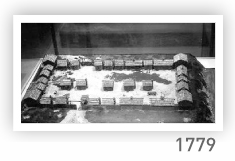1600s-1700s: Seeking game attracted to salt licks around present day Nashville, Native Americans such as the Cherokee, Chickasaw and Shawnee hunt seasonally in the area. French Lick is a popular area just north of present day Nashville.
1710: Recognizing French Lick as a gathering area for hunters, French trader Charles Charleville establishes a trading post--exchanging goods with tribes in the area.
1748: The Cumberland Valley is first recognized as a potential place for colonization once Colonel Richard Henderson, founder of the Transylvania Land Company sends word back to North Carolina and Virginia Settlements that the Cumberland Valley is ‘bountiful and apt for settlement’.
1769: French trader, Timothy Demonbreun begins a series of wintertime trips to Nashville to hunt and buy furs from Native Americans. At first he lives in a cave near Sulphur Springs and French Lick, and later builds a cabin.
1775: Colonel Henderson returns to the Cumberland Valley, this time to purchase land from the Cherokee. He acquires the land along the west bank bluffs, part of today’s downtown area.
1779: James Robertson and John Donelson settle in Nashville; Robertson makes way to Nashville via land, Donelson makes way via water on flat boat. Fort Nashborough along with three other “stations” or “forts” are built within vicinity of downtown.
1780: Richard Henderson writes the Cumberland Compact, establishing first Euro-American civil government in the area. It is signed by 256 settlers.
1784: Davidson County is established, and the settlement’s name changes from
Nashborough to Nashville.
1795: Treaty with Spain opens up the Mississippi River to more trade. Twenty-three years later, the first steamboat arrives in Nashville from downstream in Mississippi. River transport is revolutionized and Nashville experiences growth as trade increases along the Cumberland.




